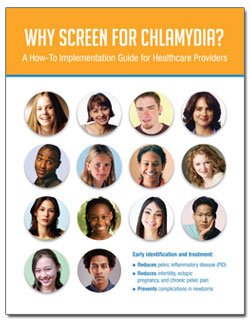The most recent Sexually Transmitted Disease Surveillance Report, released by the CDC in October, revealed that 1,526,658 cases of chlamydia were reported in 2015—the highest number of annual cases of any condition ever reported to CDC. But the reported rate does not necessarily reflect the total burden of chlamydia either; because the infection is asymptomatic in most people (about 7 out of 10), many cases are undiagnosed, despite the recommendation from the U.S. Preventive Services Task Force (USPSTF) calling for annual chlamydia for all sexually active adolescents and young women age 25 years and under.
The resources in this section of this site are designed to help you learn more about how to integrate chlamydia screening into clinical practice. Here, you can determine ways to address issues, such as maintaining confidentiality for teen patients and taking a sexual history.
Screening for Chlamydia
Routine chlamydia screening is recommended for all sexually active adolescents and young women age 25 years and under. Women over age 25 with risk factors such as new or multiple sex partners, all pregnant women, and men who have sex with men, or are in high risk settings should also be screened. Chlamydia is easily detected from a swab or urine specimen and treated with antibiotics. Rescreening and treating sexual partners prevents re-infection. The National Commission on Prevention Priorities ranks chlamydia screening as a high value, but underused clinical preventive service. Chlamydia screening could reduce the incidence of pelvic inflammatory disease (PID) by up to 60%. To view the most recent HEDIS screening data, click here.
 Why Screen for Chlamydia? An Implementation Guide for Healthcare Providers covers the latest information and tools for healthcare providers to improve delivery of chlamydia screening to patients and make chlamydia screening and care a routine part of a medical practice, including ways to:
Why Screen for Chlamydia? An Implementation Guide for Healthcare Providers covers the latest information and tools for healthcare providers to improve delivery of chlamydia screening to patients and make chlamydia screening and care a routine part of a medical practice, including ways to:
- Improve the delivery of chlamydia screening and retesting
- Make screening for and treating chlamydia routine practice
- Provide confidential care to adolescents
- Take a sexual history
